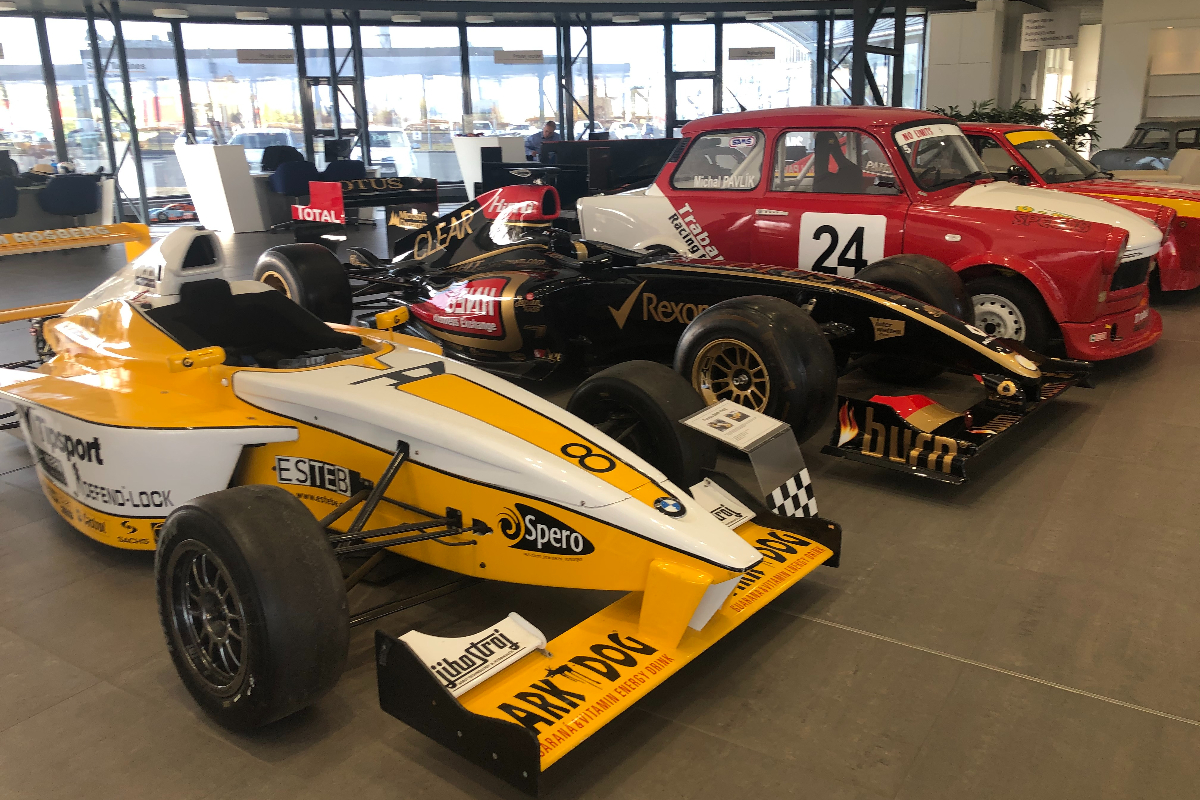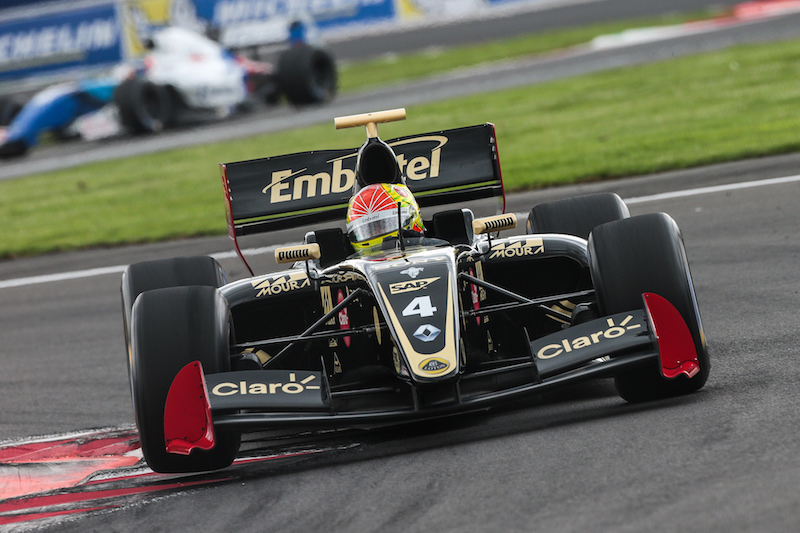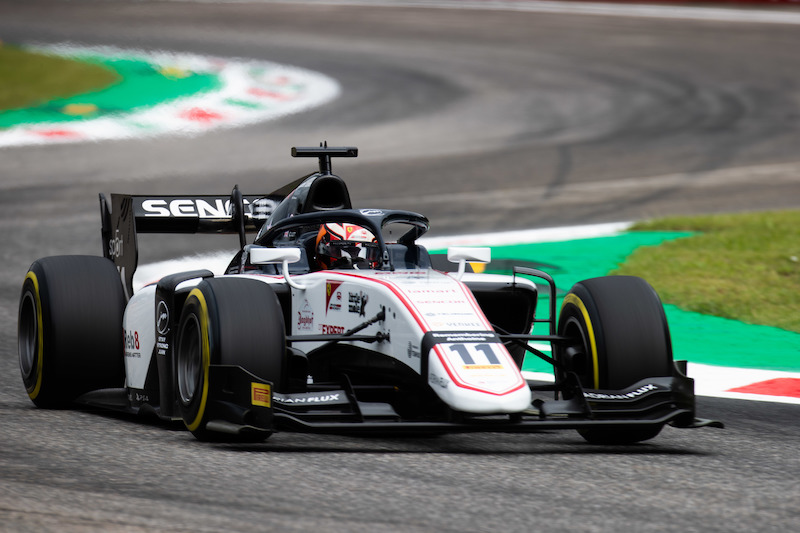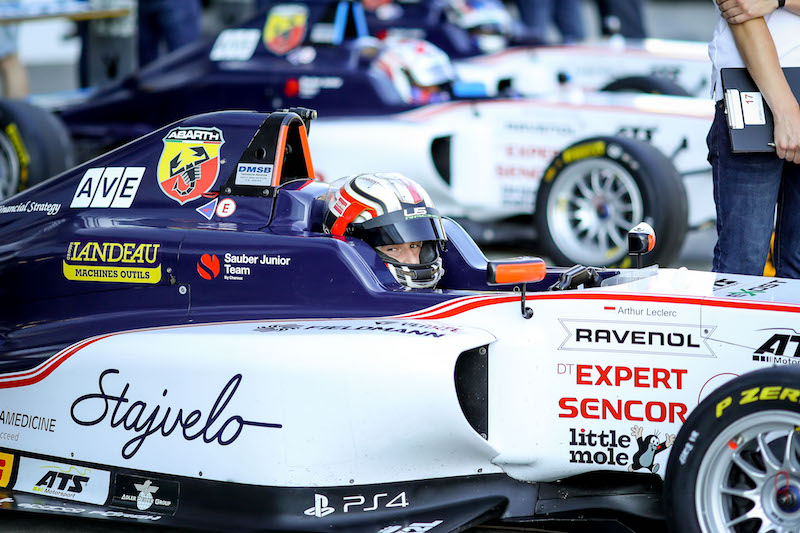
Photos: Formula Motorsport Limited
After a breakthrough 2021 in F3, Charouz Racing System is on the up. Roger Gascoigne paid them a visit
Tucked away behind a Ford service centre and a petrol station halfway between Prague and Pilsen in the Czech Republic is perhaps not where you would expect to find a race-winning team in both Formula 2 and FIA Formula 3.
But the unassuming location is home to Charouz Racing System’s 3,500 square-metre engineering facility. As team principal Bob Vavrik notes with a smile: “It might not be Maranello but it is also not a 20-year-old garage.”
Formula Scout sat down with Vavrik at the headquarters during the winter to find out more about the team’s history and ambitions for the future.
As we talk, Vavrik is busy fielding calls from potential drivers for the team’s seats for 2022. On the back of a best-ever fifth place in the teams’ championship in F3 last year, demand is high.
“We’ve been talking to more than 10 drivers; it will come less but it’s still more than the seats you have. In F2, we have had good results in the past, so although this season didn’t look so good for us there’s still a lot of interest.”
But pitted against some of the biggest names in junior single-seater racing, is fifth place the best position it can realistically achieve?
“Of course, we want to win the F3 championship but you need to be honest with yourself and to be objective,” replies Vavrik. “The dream is always stronger than the mind!
“With this team, I think we are able to fight for the championship, I’m pretty sure. I don’t want to say it will be next year as, of course, we also need to be lucky enough to put together a good package.”
Getting the right mix of drivers is crucial. “If we had had three drivers like Logan [Sargeant] last season, then we would already have been fighting for the top three easily, because we had one driver who scored nearly all the points for us to be P5.”
So, with three times the points “you are easily fighting for the championship”.
“If you start something like this, you need to really survive in the category for at least five years to get the results. You learn how the people work in the organisation, you need to know who to talk to, who to ask.”
The larger teams will inevitably attract the most highly-rated and best-financed drivers but “the top three teams have only nine seats [between them], not everybody can fit into nine seats”.
“We are a small team, we need to put together the performance of the driver and the budget. Not all drivers can fulfil both requirements. [But] once you are in the top three you can ask for more money.
“For us it is not a question of how much of the budget is left for the owner of the team. Toni Charouz doesn’t race to make a profit. However, we are no charity, so we have a budget and it is fully spent, but not to make Toni more rich. For him, it’s to enjoy it because he’s a fanatic of motorsport and race cars. Racing is his passion.”
Team owner, Antonin (Toni) Charouz, is himself a former racing driver who began hillclimbing in his native Czechoslovakia back in 1975 at the wheel of a Fiat 127.
He won the “Golden Steering Wheel”, for being the most successful Czech racing driver of the year five times between 1985 and 1992, and in the mid-1980s competed in the World and European Touring Car Championships at the wheel of a Toyota Corolla GT, winning his class at Brno in 1987. Vavrik recounts how his boss’s driving career turned into team ownership.
 “Toni started with Skodas and Zastavas and all these little cars in the Czech championship and that’s how he built up his own team. They were working from his own house in his garage. Once the Iron Curtain came down [in 1989] we could go and race outside [the country].”
“Toni started with Skodas and Zastavas and all these little cars in the Czech championship and that’s how he built up his own team. They were working from his own house in his garage. Once the Iron Curtain came down [in 1989] we could go and race outside [the country].”
Vavrik himself has been involved with Charouz since 1995 although “I can’t remember exactly how I started working with him, we just started and then got closer and closer”.
The team moved into single-seaters with Formula BMW, and achieved success in Auto GP and International Formula Master where it ran Charouz’s son Jan to the 2006 title.
Charouz ran the Czech team in A1GP, taking one victory with Tomas Enge at the wheel. In the second season, the team also took over the running of the Brazilian entry owned by Emerson Fittipaldi. Charouz’s relationship with the Fittipaldi family is deep and long-lasting, with his grandsons having raced for the team in recent years.
The team participated three times in the top class of the Le Mans 24 Hours, and as Aston Martin Racing Eastern Europe in 2009 finished fourth as well as winning the Le Mans Series outright with Charouz, Enge and Stefan Mucke at the wheel of its Lola-Aston Martin B09/60 LMP1 car. At the same time, the team was active in rallying, GT sportscars and one-make saloons.
“I think there was a season when we had around 20 cars from different categories, which was pretty busy,” comments Vavrik.
The next step was Formula Renault 3.5 in 2011, in a tie-up with the Gravity Sports Management driver development company helmed by Eric Bouiller that was intrinsincly tied to the then-owners of what is now the Alpine F1 team. That meant it was entered as Lotus for six years, even after the brand left F1. Charouz won both titles in the series’ final year, when it was known as Formula V8 3.5 after Renault’s withdrawl of support, with Pietro Fittipaldi in 2017.
The introduction of a new chassis to F2 then provided the trigger for the team to make a sideways move, and with Ferrari Driver Academy branding on its cars after ending its Lotus association.
“It was the most logical step because we had the team, the facilities, everything was just ready to do this sport. And of course, FV8 3.5 was already a really high category from the professional side,” Vavrik explains.
Charouz had failed to “get in on the first go” when applying to enter what was previously GP2, but as FV8 3.5’s champion team this time they were accepted “because they [F2 promoter Formula Motorsport] are looking for a team which is stable in motorsport, and also, let’s say, credible” with not just their presentation and history, “but also budget-wise”.
Antonio Fuoco and Louis Deletraz formed Charouz’s line-up for its rookie F2 season, which returned it to the F1 support paddock after 14 years away having contested GP2’s predecessor International Formula 3000 in 2003.
Charouz had been in discussions with Deletraz for some time: “Fuoco was part of the Deletraz deal, somehow, because FDA supported Fuoco but Charouz also supported Fuoco, and part of the deal was also Deletraz.”
Initially there was no direct link with Ferrari, “but then we made a link,” adds Vavrik.
Despite taking two wins with Fuoco, including a one-two in the Monaco sprint race, the FDA connection lasted only a year after “Massimo Rivola, the driver manager for the FDA guys, left FDA to go to MotoGP, and then came the idea to work together with Sauber”.
The 2019 tie-up with Sauber (the Swiss F1 operation now racing as Alfa Romeo Racing) seemed to establish Charouz as a major player on all rungs of the F1 ladder, as it entered the new FIA F3 Championship and also partnered with Formula 4 team US Racing. Most teams in FIA F3 had contested the GP3 series it replaced, but Charouz had no experience of single-seaters’ tertiary tier bar its FMaster campaign 13 years prior.
But at the time, Antonin Charouz heralded the Sauber deal as “the beginning of an exciting new chapter in our team’s history” and was confident in its F3 entry. So why did the team decide to join the fledgeling series?
Well, with Charouz working alongside US Racing in F4, the “whole idea was to generate at least a few [drivers] from all of them, who would continue with us” into F3 to then progress to F2.
But the expansion proved more difficult than Vavrik expected: “From FV8 3.5 to F2 was simple because it was just going from two cars from two cars, but to get another three cars, means another five drivers, five sponsors or fathers, and it’s a mess. But once we grabbed this also on the side, it was not a big step [technically], but from the human resources perspective, it was much more difficult for us.”
However, the relationship with Sauber became, in Vavrik’s words, “crazy big, because we thought it will be more serious, but the deal went up and then down, not in the best way for either side, but more for us because it cost us some money”.
According to Vavrik, the relationship foundered due to “a combination of factors; both performance and finance. It was not based on our results, of course they’re looking for performance, but they’re looking also for longer and better co-operation, and it’s always easier if you have someone next to your door than from so far [away]”.
Vavrik is reluctant to discuss the divorce in more detail as “it’s still a bit fragile, a bit sensitive”.
It’s clear that expectations of the relationship quickly diverged, with Vavrik “expecting kind of more technical support from them and this was never going to happen”, and like with the FDA the partnership lasted just one season.
The tie-up with US Racing, however, proved extremely successful. The team took Lirim Zendeli and Theo Pourchaire to the ADAC F4 title in 2018 and ’19 respectively, and Zendeli and Pourchaire’s F4 team-mate Roman Stanek both went on to race for Charouz in F3.
There’s no involvement in F4 anymore post-Sauber, but “we didn’t split [with US] for good; we still speak to each other. it’s a cooperation which is more about friendship, because Toni has been a very good friend of Gerhard for ages.”
With F2 and F3 heavily populated at the top by drivers from F1 junior teams, is it still possible for a team running a line-up without that associated support to compete for titles?
“All these academies are supported by people from these F1 teams, who are dedicated just to search for the driver, take care of them and bring them to the next category. The drivers get support from Alpine, Ferrari or whoever. Then he goes to F4, F3 and of course, it’s much easier for these guys.
‘If you have a look on the results, where was Hitech in 2020? Where were we this year? We came to the last race just one point behind Hitech and we finished one point ahead, and that’s only with one driver scoring points. So, you have straightaway the answer. If you have the drivers, you have the results.”
Fighting against better financed and larger teams requires tight control of budgets. Charouz for example was forced to part company with David Beckmann midway through the 2021 F2 season for budgetary reasons.
“If he stayed with us for the rest of the season, we would have been able to make good results, even victories or podiums. We really liked the guy and we worked well together but you need to think of the future, to be sure that your decision doesn’t kill the team.”
The compact nature of Charouz does provide greater flexibility, Vavrik believes, and some drivers flourish in the more family-like atmosphere. Enzo Fittipaldi, younger brother of Pietro, even moved to Prague after joining the team for F3 last year. He ended 2021 in its F2 line-up, and remains there for the upcoming season alongside former Esports star Cem Bolukbasi.
 Over winter HWA Racelab left F2 and F3, and rumours often swirl that teams such as Charouz may end up on the market.
Over winter HWA Racelab left F2 and F3, and rumours often swirl that teams such as Charouz may end up on the market.
“Toni doesn’t plan to leave but, of course, he is a businessman,” Vavrik reassures. “As he says, ‘everything is for sale, if somebody can come with some offer’. We are not on the way to leave, but anything can happen tomorrow, you never know.”
In recent years, Antonin Charouz has exited some of his other business activities, ostensibly to be able to devote more time and funds to the racing “where his heart is”.
And as mentioned at the begining, that heart lies in a workshop in the Czech countryside. Is being based away from motorsport’s traditional heartlands, such as Italy and the UK where many of its rivals are, a disadvantage?
“To be honest, I don’t see any advantage or disadvantage in being based in the Czech Republic,” he says. It helps with logistics that “we are in the middle of the Europe, so everywhere you go it’s not so far”.
“The team draws on talented engineers and mechanics from across Europe, and even beyond. We have like six or seven nationalities, sometimes even from Russia or Japan. It’s like a football team, you’re also looking for the best players, no matter the nationality. We have Czech guys, and even more for this season but it’s not just a question of grabbing some Czech guys and making a team.”
“Of course, I am a big patriot at heart. We are all fighting as a Czech team. Being Czech myself, I feel I do something for our flag. When we are there it’s always nice if the Czech boys come from a little country and kick the arses of all the English or French teams in a sport which they think is theirs.”
What have been the highlights so far in Vavrik’s varied career in motorsport, including almost 17 years with Charouz?
“All of us liked the LMP1 times and cars. It was Toni’s idea, he brought that together with Prodrive.”
During the successful Aston Martin project, Vavrik spent two years living in the English market town Banbury where Prodrive, F1 team Haas and Formula Regional entrant Arden are based. Another highlight was far more recent.
“The Monaco F2 race where we had the double podium was also something very special and I’m not sure how many times in your life you can get something like this. And in your first season in F2, that was also something really good.”
And disappointments?
“I don’t think I have any. Of course, it’s a sport – you have wins and losses and the human brain is geared to remember only the positives. Maybe it’s different from the real life or financial side of the business, but from the sporting side you can have only an optimistic view. I am first and foremost a sportsman. When you love it, you do it from your heart.”
Top Charouz Racing System stars
A list of drivers who raced for the team during their junior single-seater careers. Results with Charouz in italics
Antonio Fuoco – 5th in 2021 World Endurance Trophy for GTEAm, 3rd in 2016 GP3 – 7th in 2018 F2
Matthieu Vauxiviere – 3rd in ’21 WEC, 3rd in ’21 Le Mans 24H – 2nd in 2015 FR3.5
Callum Ilott – currently 19th in 2022 IndyCar, 2nd in 2020 F2 – 11th in 2019 F2, 6th in ’19 Macau GP
Marco Sorensen – 2016 & 2019-20 WEC GTE champion, 11th in 2014 GP2 – 6th in 2012 FR3.5
Jan Charouz – 2009 LMS champion, 4th in ’09 Le Mans 24H, 12th in 2006-07 A1GP, ’06 Int. FMaster champion
Rene Binder – ’21 ALMS champion, 7th in ’21 ELMS, 28th in ’18 IndyCar – 4th in 2017 FV8 3.5
Pietro Fittipaldi – 23rd in ’20 F1, 15th in ’19 DTM, 26th in ’18 IndyCar – 2017 FV8 3.5 champion
Lirim Zendeli – 17th in ’21 F2 – 18th in ’19 FIA F3, 2018 ADAC F4 champion
Logan Sargeant – 3rd in ’20 FIA F3, 3rd in ’19 Macau GP – 7th in ’21 FIA F3
Jaroslav Janis – 3rd in ’06 FIA GT, 14th in ’05 SF – 8th in 2003 Int. F3000, 3rd in ’06 Int. FMaster, 12th in ’06-07 A1GP
Further reading
Why Pizzi believes his ‘unexpected’ FIA F3 move with Charouz is the right step
F2 testing hinted at who will be at the front, but F3 did the opposite
Why Sauber now has its own junior team [February 2019]









